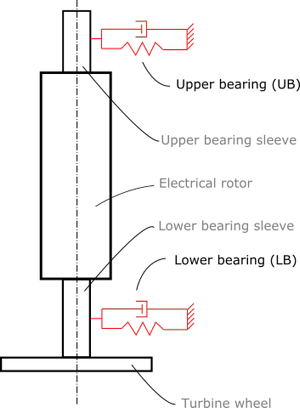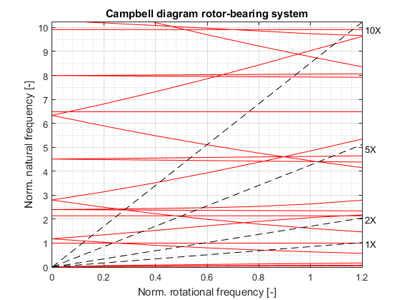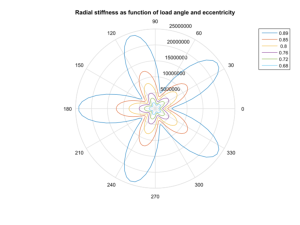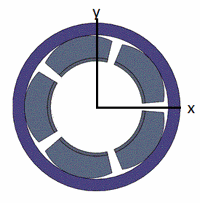A generic rotor dynamics model of a vertical rotor-bearing system
Rogier Labee – Triogen B.V. (June 2015 – April 2016)

Summary
Triogen is a supplier of Organic Rankine Cycles (ORC). These machines convert thermal energy into electrical power. The generator is driven by a turbine wheel, which is mounted on a single shaft, together with the main pump. This shaft is vertically aligned and supported by tilting pad bearings. At full load, the shaft rotates with approximately 25.000 RPM.
Investigating the rotor dynamic behaviour of the current system is one of the main goals of this research. Also, the influence on the rotor dynamic behaviour of changes in operational parameters or design is very interesting for the company. To obtain this knowledge, a generic rotor dynamics model is developed.
Figure 1: Model of the rotor-bearing system (simplified)
|
Figure 2: Campbell diagram of the rotor bearing-system (normalized axes) |
The rotor dynamics model (fig. 1) consists of the radial bearings and the shaft, including the turbine wheel and main pump. Due to the nature of tilting pad bearings, the stiffness and damping coefficients of these bearings is very dependent on the position of the shaft in the bearing clearance. This shaft position is unknown, and therefore the relevant bearing properties are determined throughout the bearing clearance (fig. 3). The combined model predicts natural frequencies as function of rotational frequency (fig. 2), which is plotted in a Campbell diagram, together with the excitation frequencies.
The rotor dynamics model is subjected to several validations. First of all, the natural frequencies of a static shaft have been measured with an impact hammer test. Also, the vibrations of a rotating machine are measured. These measurements combined showed that the model seems to predict the correct rotational frequencies at which resonance could occur.
Key Results
- A generic rotor dynamics model is developed, that predicts natural frequencies of the system as a function of the rotational frequency of the shaft (red lines fig. 2).
- These natural frequencies in combination with the excitation frequencies indicate at which rotational frequency resonance could occur (intersections in fig 2.).
- The influence of the unknown shaft position is negligible, since the stiffness of the tilting pad bearings can be considered very weak, compared to the shaft, in all cases.
- The measured natural frequencies for the static case, as well as several resonances at higher rotational velocities indicated that the model seems to be correct (some limitations with the current vibration measurements need to be resolved to obtain a more solid validation).
- The model is used to investigate the influence of a change of bearing type (and thus a change in support stiffness and damping). This causes additional critical speeds, as well as a shift of already existing critical speeds.
Figure 3: Radial stiffness as function of shaft position (left) of the tilting pad bearings (right) |




